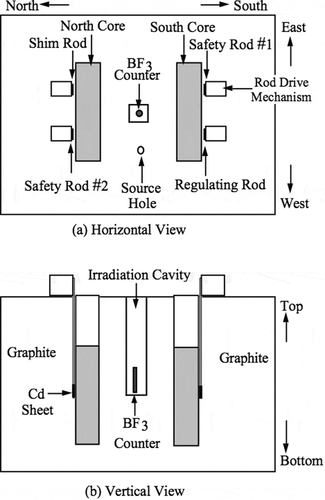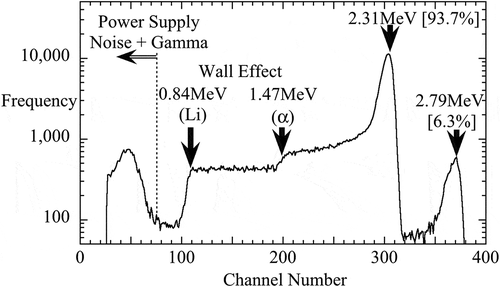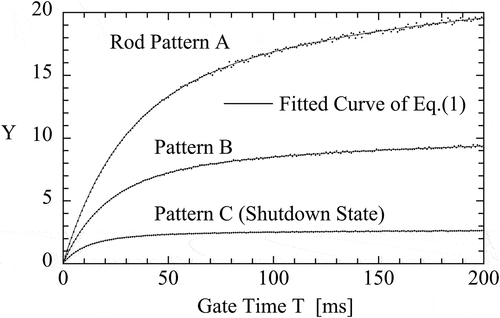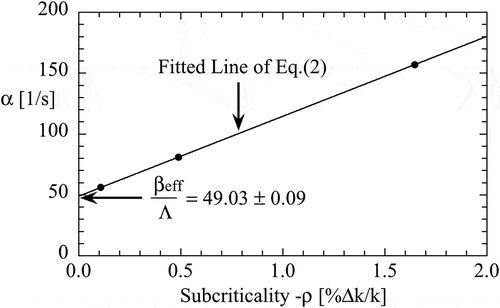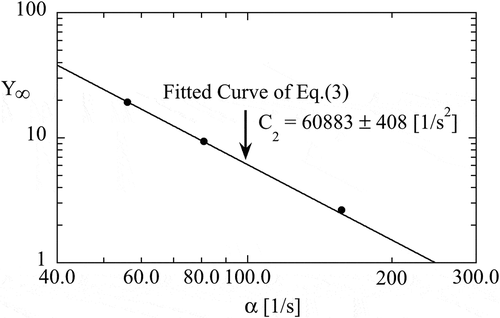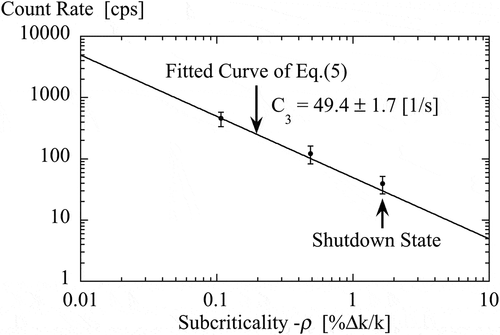 ?Mathematical formulae have been encoded as MathML and are displayed in this HTML version using MathJax in order to improve their display. Uncheck the box to turn MathJax off. This feature requires Javascript. Click on a formula to zoom.
?Mathematical formulae have been encoded as MathML and are displayed in this HTML version using MathJax in order to improve their display. Uncheck the box to turn MathJax off. This feature requires Javascript. Click on a formula to zoom.ABSTRACT
Even a zero-power reactor core containing highly enriched uranium has a weak neutron source inherent in uranium 235, and consequently, a neutron counter placed closely to the core without external neutron source registers a certain counting rate. The study of the counting is very important for zero-power reactor physics experiments with a high precision. In this experimental study, first, at a shutdown state of the UTR-Kinki reactor without start-up neutron source, a pulse height distribution of output signals from a neutron proportional counter was measured to confirm that these signals resulted from neutron detections. At several subcritical states of the UTR, then, the Feynman-α analysis was carried out to confirm that the neutrons detected by the counter must be fission neutrons multiplied by fission chain reactions. The correlation amplitude measured in the Feynman-α analysis was much higher than that measured in a previous drive by start-up source. Further, it was also confirmed that the subcriticality dependence of neutron counting rate followed the source multiplication formula. This feature indicated that the one-point model was very successful in the subcritical range including the shutdown state.
1. Introduction
A reactor core including transuranium nuclides has an intense inherent neutron source arising from spontaneous fission of these nuclides and (α, n) reactions of light-medium nuclides of fuels. A low-enriched uranium core also has a certain source inherent in a large amount of uranium 238. However, even a zero-power reactor containing highly enriched uranium must have a weak neutron source inherent in a large amount of uranium 235, and consequently, a neutron counter placed closely to the core without external source may register a certain output. The study of the above neutron detection is very important for zero-power reactor physics experiments with a high precision. For example, a judgment of criticality should be done in a higher power range where an influence of the inherent source on the counter output is negligible. In reactor kinetics experiments such as a rod drop experiment, the measured counter output should be corrected for a certain contribution from the inherent source. Various subcriticality measurements such as the Feynman-α analysis [Citation1,Citation2] and the neutron source multiplication method [Citation3] have been performed in low-enriched uranium assemblies driven by the inherent sources [Citation4–Citation6]. However, the experimental reactor-physics study for a highly enriched uranium core driven by the inherent source has been hardly reported. This is because an influence of the above weak source on reactor physics experiments has been expected to be negligible. Naturally, even few neutrons emitted from such a weak inherent source must be much multiplied at a slightly subcritical state. It is considered very worthwhile to confirm how much counts do the inherent source give to a neutron counter in a highly enriched uranium core and whether the inherent source is useful or injurious to a reactor physics experiment.
In this experimental study, first, at a shutdown state of the Kindai (former name was Kinki) University Training and Research Reactor (UTR-Kinki) without start-up neutron source, a pulse height distribution of output signals from a neutron proportional counter was measured to confirm that these signals resulted from neutron detections. At several subcritical states of the UTR, then, the Feynman-α analysis was carried out to confirm that the neutrons detected by the counter must be fission neutrons multiplied by fission chain reactions. Further, it is also confirmed that the subcriticality dependence of neutron counting rate followed the source multiplication formula. Our UTR, whose maximum thermal power is only 1 W, contains highly enriched uranium fuels (around 90% enrichment) including no transuranium nuclide and a very smaller amount of 238U compared to 235U. Therefore, the inherent neutron source is expected to generate from a significant number of (α, n) reactions between α particles emitted from radioactive decay of 235U and aluminum nuclides of base fuel material, but from only a few spontaneous fissions of 238U. The above confirmations must be useful for further reactor physics experiments in not only the UTR but also many critical assemblies containing highly enriched uranium fuels. In this report, the reactor configuration and the experimental setups are described in Section 2, and the discussion on the results in Section 3 prior to conclusions summarized in Section 4.
2. Reactor configuration and experimental setups
2.1. Neutron source inherent in nuclear fuels
A fuel plate of the UTR is made of a 90%-enriched uranium and aluminum alloy plate (UAl4 + Al) with an aluminum cladding (approximately 0.4 mm thick, A1100). The size of the alloy plate is approximately 585 mm long, 70 mm wide, and 1 mm thick, and the weight ratio of uranium to aluminum is approximately 0.24. The nominal uranium mass per plate is 24.7 g. A fuel assembly is usually consisted of 12 fuel plates with the exception of some assemblies for adjustment of excess reactivity. The 12 assemblies are loaded to operate the UTR. In the above fuel plate, the inherent neutron sources originate primarily from spontaneous fissions of 238U and (α, n) reactions of 27Al induced by α-decays of 235U. The inherent source strength originating from these reactions is shown in , where the spontaneous fission rate is estimated using a spontaneous fission fraction 5.45 × 10−5 % per α-decay of 238U [Citation7], and the (α, n) reaction rate of 27Al is estimated using a neutron yield 2.409 × 10−6 [n/α] for energy spectrum of α emitted by 235U decay [Citation8]. As shown in this table, the contribution of (α, n) reaction to the inherent source strength is dominant in highly enriched uranium fuels of the UTR. It is noted that a reactor start-up neutron source for the UTR has the strength of 1.2 × 106 [n/s] and the estimated strength of inherent neutron source of whole core is about 1/2000 of the start-up-source strength.
Table 1. Inherent neutron source strength [neutrons/s]
2.2. Reactor configuration and nuclear instrumentation
The UTR-Kinki reactor is a light-water-moderated and graphite-reflected two-core reactor. The reactor configuration and neutron counter location are shown in . The six fuel assemblies are loaded in the respective core tanks separated by 18 in. (45.7 cm) of graphite. The graphite region between the tanks has been employed as a standard irradiation field. Additional graphite surrounding the tanks acts as a neutron reflector. The reactor has four control rods in symmetrical positions. In these rods, two are assigned as safety rods for reactor scram and manual shutdown, and are referred to as safety rod #1 and #2, respectively. Others are a shim rod for scram and coarse adjustment of reactivity, and a regulating rod for auto-operation and fine adjustment of reactivity. At a shutdown state of the UTR, these four rods are completely inserted to a lower-limit position.
A BF3 proportional counter (LND-202101, 1.0 in. dia., 15.47 in. len.) was placed in an irradiation cavity located between the two core tanks, as shown in . The nuclear instrumentation system consisted of neutron counter bias-supply, pre-amplifier, spectroscopy amplifier and discriminator modules. Linear output signals from the spectroscopy amplifier were fed to a multi-channel analyzer to measure a pulse height distribution of output signals from the BF3 counter at the shutdown state of the UTR without a start-up neutron source. Logic pulses outputted from the discriminator were fed to a time-sequence data acquisition system, which registered arriving time of the signal as digital data. Time-sequence counts data within a time interval (gate time) of 1 ms were generated from the arriving time data, and then the count data within longer intervals were synthesized by the conventional bunching technique [Citation9] to calculate a gate-time dependence of the Y defined as variance-to-mean ratio minus 1 of the counts data.
2.3. Experimental conditions
The time-sequence data for the Feynman-α analysis and the counting-rate measurement were acquired at three subcritical states without start-up neutron source, where the subcritical reactivity was adjusted by changing the axial positions of the four control rods. The control rod patterns of these subcritical states are shown in , where the reactivity of each pattern was determined from the rod worth calibrated by the positive period method and the rod drop method. The time-sequence data for the Feynman-α analysis had been acquired for 0.5, 1, and 3 h in the patterns A, B, and C, respectively.
Table 2. Control rod patterns employed in the present experiment
3. Results and discussion
3.1. Pulse height distribution
At this time, the UTR had no operation over two weeks, so that delayed-neutron precursors that were produced during the previous operation would completely decay out. At the shutdown state without start-up source, surprisingly, counting rate of the BF3 counter was around 40 cps. A pulse height distribution of output signals from the counter measured at the state is shown in . The neutron capture reaction of 10B nuclide releases either energy of 2.31 MeV (93.7%) and 2.79 MeV (6.3%). Not only the two peaks corresponding to these energies but also two edges originating from the wall effect can be clearly observed in this figure. These observations convinced us that these signals resulted from neutron detections.
3.2. Feynman-α analysis
shows a gate-time T dependence of the correlation amplitude Y at the three subcritical states. The gate-time dependence can be observed just as expected but the amplitude is surprisingly high beyond our expectation. The previous Feynman-α analysis gave the saturated amplitude Y∞ of around 3.3 at most in the rod pattern A, where the subcritical system was driven by the start-up neutron source and a 3He neutron counter (LND-2524, 1.0 in. dia., 21.6 in. len.) was placed at the same position [Citation10]. According to the neutron detection efficiencies measured by Hashimoto et al. [Citation11], the efficiency of the 3He neutron counter was 3.5 times as large as that of a BF3 neutron counter (LND-2029, 1.0 in. dia., 15.38 in. len.) which had the same thermal neutron sensitivity as the BF3 counter (LND-202101) employed in the present study [Citation12]. If the present BF3 counter was employed in the above Feynman-α analysis in place of the 3He counter, the saturated amplitude would be reduced to around 1. The point is, the present drive by the inherent source enhances more than 10 times the amplitude as much as the previous drive by the start-up external source.
As shown in , a neutron counter placed in the irradiation cavity directly looks at the start-up source inserted in the source hole and consequently the counter must detect a large amount of neutron emitted from the strong external source. The detection of the neutrons conforming to the Poisson statistics must significantly reduce the correlation amplitude. In another drive by the inherent source, however, the neutron counter detects no neutrons from the external source and consequently the Feynman-α analysis never suffers from the reduction of the correlation amplitude. Therefore, a drive by the inherent source must be advantageous for various neutron correlation analyses. When we are about to place a neutron counter for the Feynman-α analysis, there is no need to consider the position of an external source.
We carried out a least-squares fit of the following formula to the Y data:
The last term of the above equation was introduced to consider a delayed-neutron contribution to the Y [Citation13] and C1 was a constant related to the contribution. The fitted curves are included in , where these curves are in very good agreement with the Y data and the correlation coefficients of the fitting are over 0.999. The result of the Feynman-α analysis convinced us that the neutrons detected by the counter were fission neutrons multiplied by fission chain reactions.
shows a subcriticality dependence of the prompt-neutron decay constant α inferred from the above fitting. The statistical uncertainty of α induced by the fitting is less than 1. Assuming the one-point model, the decay constant can be described as
The above notations are conventional. A least-squares fit of EquationEquation (2)(2)
(2) is included in this figure, where the fitted line is also in very good agreement with the decay constant data. The decay constant 49.03 ± 0.09 [1/s] inferred at the critical state is consistent with 49.48 ± 1.16 [1/s] obtained applying the second-order difference-filtering Feynman-α analysis [Citation14], which was developed to reduce the influence of reactor-power drift at a critical state and the contribution of delayed neutrons. This feature indicates that the one-point model is very successful in the present subcritical range including the shutdown state. shows a dependence of the saturated amplitude Y∞ on the decay constant α where the respective amplitude and constant are inferred from the fitting of EquationEquation (1)
(1)
(1) . The statistical uncertainty of Y∞ induced by the fitting is less than 0.1. The saturated amplitude also can be described as:
where
When spontaneous fissions dominantly contribute to an inherent source strength, the subcriticality and the multiplicity of the spontaneous fission neutrons should be included in the above constant C2 [Citation15]. As shown in , however, spontaneous fissions scarcely contribute to the present inherent source and EquationEquation (4)(4)
(4) probably has no need to be changed. We carried out a least-squares fit of EquationEquation (3)
(3)
(3) to confirm that the fitted curve was in good agreement with these data and consequently the subcriticality dependence of the constant C2 was negligible.
3.3. Source multiplication characteristics
shows a subcriticality dependence of average counting rate with standard deviation of the average, where the average and the deviation were determined from time-sequence counts data within the gate time of 1 s. The counting rate increases with a decrease in subcriticality. A least-squares fit of the following source multiplication formula to the counting rate data was done:
where
The notations of the above equations are conventional. As shown in this figure, the counting rate follows the above formula and consequently the one-point model is successful in the present subcritical range including the shutdown state. The inherent source is uniformly distributed in uranium fuels of reactor core and the uniform distribution of the source excites dominantly a fundamental spatial mode of the reactor system. The dominant excitation of the fundamental mode reduces the spatial effect of higher modes. At a deeply subcritical state, however, any external neutron source placed outside the core must significantly excite the spatial higher modes and consequently the one-point model falls into failure. The previous neutron source multiplication measurement gave an apparent spatial dependence on external source position [Citation16]. The reactor drive by the inherent source must be more advantageous for neutron source multiplication method than any drive by an external source. However, it should be noted that a deeper subcritical state than several dollars lead to a significant spatial dependence under even a drive by the inherent source [Citation5].
4. Concluding remarks
At the shutdown state of the UTR without start-up source, a pulse height distribution of output signals from a BF3 counter was measured and the observation of the distribution convinced us that these signals resulted from neutron detections. Then, the Feynman-α analysis was carried out and consequently it was confirmed that the neutrons detected by the counter must be fission neutrons multiplied by fission chain reactions. The present correlation amplitude was much higher than that measured in a previous drive by start-up source. Further, at three subcritical states of the UTR without start-up source, neutron counting rates of the counter were measured to reconfirm that the subcriticality dependence of the count rate followed the source multiplication formula.
Contrary to our expectation, the count rate of the BF3 counter was surprisingly high at each subcritical state. Up till now, we had given up on any reactor physics experiments for a reactor driven by an inherent source of highly enriched uranium fuels. However, the present study confirmed that the Feynman-α analysis was applicable to the drive by the inherent source and the drive had the advantages for the analysis, where the advantages were previously observed for some low-enriched uranium assemblies. Now we expect that the inherent neutron source may be available to various future reactor-physics experiments for highly enriched cores to enhance the experimental qualities. Meanwhile, we are worried that no influence of the inherent source had been considered for most of our previous experiments and the inherent source might be injurious to some experiments. We consider that the many reactor physics experiments previously done in the UTR should be reexamined from the viewpoint of an influence of the inherent source.
On the other hand, the inherent neutron source may be available for various future reactor-physics experiments using a sensitive neutron counter. Especially, the inherent source must be advantageous for various neutron correlation analyses, since uncorrelated neutrons emitted from a Poisson source such as an Am-Be source scarcely exist in a reactor core but most neutrons are correlated neutrons resulted from fission chain reaction. Further, the one-point kinetics model is expected to be more satisfactory for a drive by the inherent source than that by any external sources. At a deeply subcritical state, any external source placed outside nuclear fuels forms a neutron flux distribution dependent on the source position and consequently the one-point model fails. Now, we and joint researchers are studying various reactor physics experiments on the inherent source in not only the UTR but also the Kyoto University Critical Assembly (KUCA) [Citation17]. In all highly enriched uranium cores of the UTR and the KUCA, and most of low-enriched uranium cores of the KUCA, any contribution of the inherent source to various reactor-physics experiments has been never considered. First, the effect of the no consideration on these experiments should be experimentally estimated. Next, we will promote the study in some experiments such as neutron correlation analyses, to which the inherent source is considered useful.
Disclosure statement
No potential conflict of interest was reported by the authors.
References
- Feynman RP Statistical behavior of neutron chains. United States: Los Alamos Laboratory; 1946, LA-591-Del.
- Feynman RP, De Hoffmann F, Serber R. Dispersion of the neutron emission in U-235 fission. J Nucl Energy. 1956;3:64–69.
- Goodman CD. The Science and Engineering of Nuclear Power. Vol. I. Boston: Addison-Wesley; 1947.
- Tonoike K, Yamamoto T, Watanabe S, et al. Real time α value measurement with Feynman-α method utilizing time series data acquisition on low enriched uranium system. J Nucl Sci Technol. 2004;41:177–182.
- Shiozawa T, Endo T, Yamamoto A, et al. Investigation on subcriticality measurement using inherent neutron source in nuclear fuel. Proc. PHYSOR-2014; 2014 Sep 28-Oct 3; Kyoto. [CD-ROM].
- Endo T, Yamamoto A, Yagi T, et al. Statistical error estimation of the Feynman-α method using the bootstrap method. J Nucl Sci Technol. 2016;53:1447–1453.
- Chart of nuclides [Internet]. Austria: IAEA Nuclear Data Section; [ cited 2018 Nov 1]. Available from: https://www-nds.iaea.org/relnsd/vcharthtml/VChartHTML.html
- Fernandes A, Kling A, Vlaskin GN. Comparison of thick-target (alpha,n) yield calculation codes. EPJ Web Conf. 2017;153:07021.
- Misawa T, Shiroya S, Kanda K. Measurement of prompt-neutron decay constant and large subcriticality by the Feynman-alpha method. Nucl Sci Eng. 1990;104:53–65.
- Hashimoto K, Ohya K, Yamane Y. Experimental investigation of dead-time effect on Feynman-α method. Ann Nucl Energy. 1996;23:1099–1104.
- Hashimoto K, Ohsawa T. Dead-time measurement of neutron counters by reactor-power variational technique. J Energy Soc Jpn. 1994;36: 227–231. [in Japanese].
- Nuclear radiation detectors [Internet]. USA: LND Inc.; [ cited 2018 Nov 1]. Available from: https://www.lndinc.com/products/.
- Hashimoto K, Mouri T, Ohtani N. Reduction of delayed-neutron contribution to variance-to-mean ratio by application of difference filter technique. J Nucl Sci Technol. 1999;36:555–559.
- Hashimoto K, Ohsaki H, Horiguchi T, et al. Variance-to-mean method generalized by linear difference filter technique. Ann Nucl Energy. 1998;25:639–652.
- Pa´Zsit I, Yamane Y. Theory of neutron fluctuations in source-driven subcritical systems. Nucl Instr Meth Phys Res. 1998;A403:431–441.
- Hashimoto K, Miki R. Space-dependent effect observed in subcriticality measurements for loosely coupled-core system. J Nucl Sci Technol. 1995;32:1054–1060.
- Misawa T, Unesaki H, Pyeon CH. Nuclear reactor physics experiment. Kyoto: Kyoto University Press; 2010.

